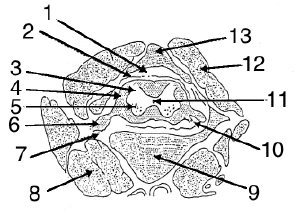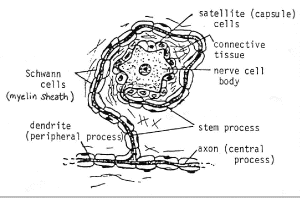Slide DMS090 [Spinal cord in situ]. Orient yourself to the location of the spinal cord.

Spinal cord in situ: 1. epidural space; 2. meninges; 3. dorsal horn gray matter; 4. white matter; 5. ventral horn gray matter; 6. dorsal root ganglion (sensory); 7. intervertebral foramen; 8. neck muscle; 9. vertebral body; 10. ventral (motor) root; 11. central canal; 12. deep neck muscle; 13. spinous process of vertebra.
Since motor cells located in the CNS distribute their axonal processes via peripheral nerves to muscle, we will examine a typical multipolar neuron located in the anterior horn of the spinal cord. These cells are large, stellate in shape, have a coarsely granular cytoplasm, and a centrally-placed, pale staining vesicular nucleus with a prominent nucleolus. The granular chromidial (Nissl) substance extends into the base of the dendritic processes. It is lacking in that region of the cells which gives origin to the single axon process, known as the axon hillock.
Using the figure (below) and textbook illustrations as guides, find ventral (motor) horn cells (neurons) in this cross section of spinal cord in situ. Observe the form of the cell and characteristic structure of the nucleus and cytoplasm. The cell has many dendrites but only one axon. These processes are very long and are usually cut off close to the cell in the preparation of this section. However, the proximal stumps lend an angular contour to the periphery of the perikaryon (cell body).
There are also dorsal (sensory) root ganglion cells in this slide (see below). These are pseudounipolar (aka “unipolar”) cells. They are globular in shape and vary tremendously in size. The small cells have unmyelinated processes and the large cells myelinated processes. A thin cellular capsule surrounds the cell bodies. The cells of this capsule are called satellite or capsule cells and are continuous with the neurolemma sheaths of the cell processes. The nucleus is relatively large and vesicular and may contain more than one prominent nucleoli. The cytoplasm appears granular due to the abundant chromidial (Nissl) substance. If a stem process (primary neurite) is in view note that it bifurcates in a T or Y fashion. Is Nissl substance present in the stem process?

The thick stem process may wind several times around the cell body and then divide into two secondary processes . . . a peripheral process ("dendrite") which extends to some sensory receptor and a central process ("axon") which enters the spinal cord to synapse with either associative or motor neurons in the gray matter.
Note that large bundles of nerve fibers traverse the ganglion and isolate nerve cells into groups. These are the central and peripheral processes of the ganglion cells. No fibers of other neurons traverse this sensory ganglion.